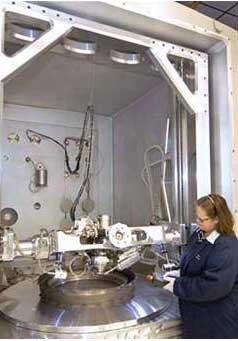Apr 1 2008
Tinker houses
the largest-known Scanning Electron Microscope in the
world.
 Judith Freer, a materials engineering technician with 30 years experience, positions the MIRA X scanning electron microscope for an F108 stage four vane assembly. The 5-foot by 5-foot by 5-foot internal capacity qualifies Tinker's new addition as the largestknown
SEM in the world, according to Metallurgical Analysis Laboratory staff.
Judith Freer, a materials engineering technician with 30 years experience, positions the MIRA X scanning electron microscope for an F108 stage four vane assembly. The 5-foot by 5-foot by 5-foot internal capacity qualifies Tinker's new addition as the largestknown
SEM in the world, according to Metallurgical Analysis Laboratory staff.
Within a 9 foot by 10 foot by 12 foot vacuum chamber, the
microscope, Germany's VisiTec Microtechnik GmbH MIRA
X, has a 5-foot by 5-foot by 5-foot operating volume. It is
capable of examining 60-inch and larger objects.
"The new MIRA X provides exciting opportunities for the
center," said Russell Howard, Oklahoma City Air Logistics
Center Engineering director. "Not only will it result in
significant cost savings and invaluable support to critical
aging aircraft issues, but we also look for its advanced and
unique capabilities to attract additional workload to Tinker
from other government agencies and private industries."
Designed from the ground up by lab personnel with input
from both internal customers and external entities, the OCALC
Metallurgical Analysis Laboratory's MIRA X can
magnify an object more than 100,000 times and its stage
can rotate 360 degrees.
"All the angular manipulations used to view an object are
accomplished by moving or rotating the column, so the piece
stays still," said Scot Roswurm, senior materials engineer
and acting chief of the 76th Maintenance Support
Squadron's Metallurgical Analysis Section. "In addition we
have detectors, instruments that gather the electron data to
provide an image, which are also moveable. So we can look at very complex geometries and even down into
some internal cavities and resolve images.
"(The microscope) is an integration of the best elements and components from manufacturers of microscopes
from all over the world," Mr. Roswurm said. "In this case, for instance, the column is actually produced by (The
Carl Zeiss Corporation), one of the finest optic and imaging companies in the world."
Previously, the lab could only magnify features of a large, intact object 70 to 80 times its original size. Also,
prior to the arrival of the MIRA X, lab technicians had to cut parts to approximately 6 inches or less to fit into its
largest standard SEM. Propulsion components were often destroyed before final investigative or interrogative
results were determined.
"If I can evaluate a large component without cutting it up, I save the time and cost of cutting it, I can also keep
the features of interest of components in their proper context, meaning that I don't have to reassemble the
pieces after the fact in order recall the position of a crack with respect to its assembly or to accomplish
subsequent dimensional analyses," Mr. Roswurm said.
The MIRA X is designed to analyze maintenance wing engine and aircraft components including compressor
rotors, damaged fan blades, shafts, spacers and air seals, fan frames, nozzle segments and thermal sprayed
parts.
Mr. Roswurm said that Mr. Angel Rivera, Principal MIRA engineer and Ms. Judith Freer, MIRA Engineering
technician recently inspected a sheath off of a boom which was 7 feet long with a fracture of nearly the same
length.
On average it takes about eight hours to complete a component interrogation, which does not include part
cleaning, part set up, chamber pump down or other preliminary procedures.
Conceptualization of the MIRA X at Tinker began more than five years ago when lab engineers brainstormed
how a large chamber microscope would benefit the Air Force. Once it was determined that an excellent return
on investment was possible, a team of lab, Physical Sciences Flight support section, and Maintenance Support
Group officials began researching how to acquire the $3 million microscope and its enclosing facility.
Since receiving the MIRA X, the lab has investigated numerous components just during its installation and
initial rollout and Mr. Roswurm said the documented savings to date on less than eight components exceeds
$70,000. Yet, each year, it is estimated to save the Air Force up to $1 million, plus the incalculable benefits of
mishap avoidance. The MIRA X was received in September and its installation was completed in November.